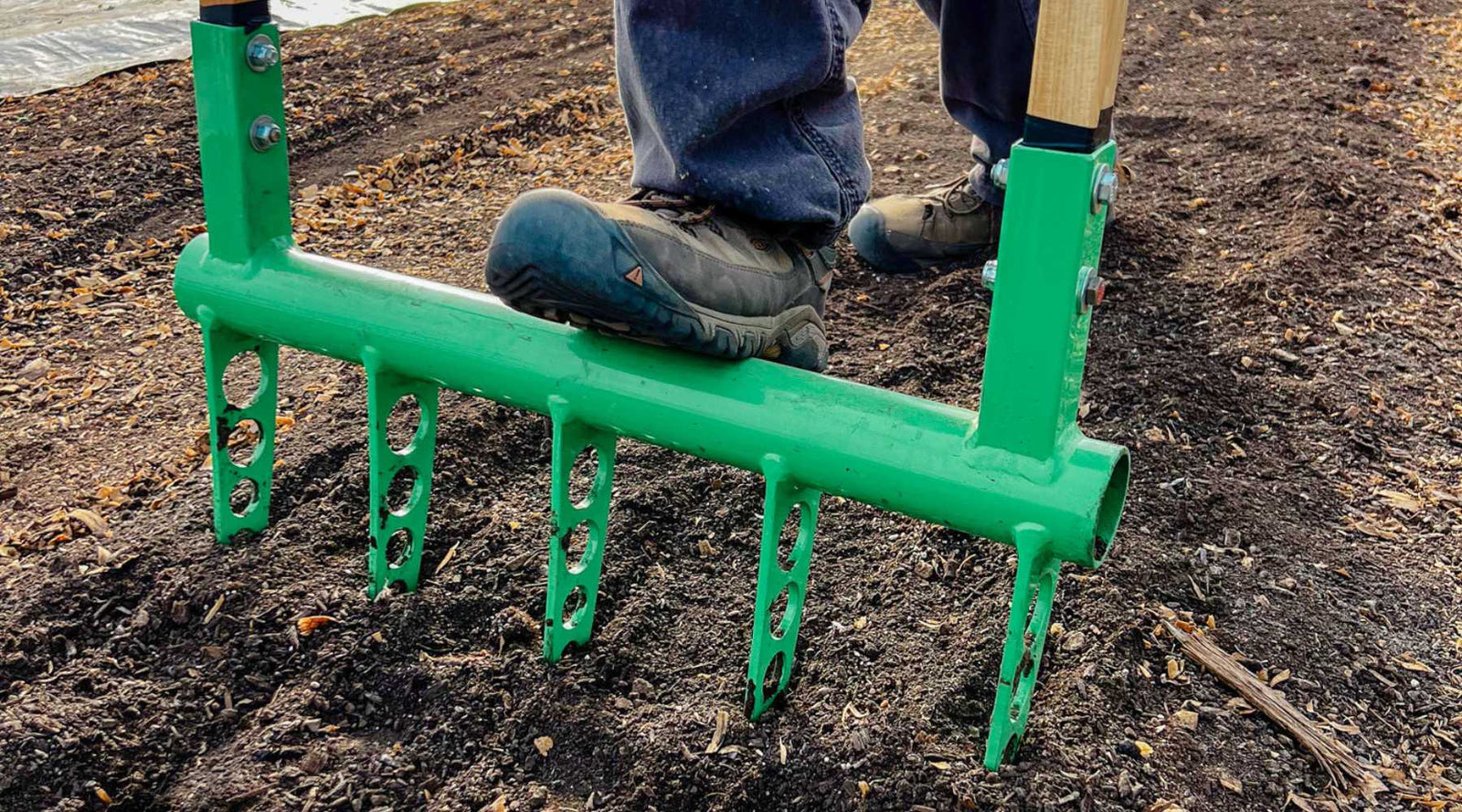Free Shipping on Orders over $75 to the Contiguous US
Free Shipping on Orders over $75 to the Contiguous US
How to Use a Broadfork: Techniques for Healthier Soil and Stronger Plants
October 30, 2025 7 min read 0 Comments

Master Broadforking: Techniques for Healthier Soil and Stronger Plants
Do you have hardpan or compacted soil? Are you looking for an efficient way to improve soil aeration and structure? Want to move toward regenerative farming? Look no further. The broadfork is going to be your new best friend. It was invented in the 1950s and popularized by Eliot Coleman. The broadfork will help improve soil and decrease erosion without heavy machinery.
What is a Broadfork?
The term broadfork is quite literal. It’s a sturdy stand-up tool with wooden or metal handles and heavy-duty, slightly curved tines. It’s wider and more durable than a pitchfork and loosens the soil without damaging the structure.
Types of Broadforks
Broadforks come in various materials, tine lengths, widths, and weights. Choose short tines for loosening weeds and harvesting root vegetables. Pick narrow, more lightweight forks for home gardens or if you have back issues. Pick 30-inch wide forks if you’re a market gardener with permanent bed systems.
The heavy-duty Bootstrap broadfork is excellent for starting new beds, loosening clay soil, and aerating soil. Because you use the weight of your body to drive it into the soil by standing on the cross bar, it reduces strain on your shoulders and back compared to other fork types.

Why Use a Broadfork?
Broad forking is preferred over heavy tillage for several reasons. This simple technique:
- Preserves the soil structure
- Increases aeration
- Suppresses weed seeds
- Enhances water retention
- Improves soil health over time
- Decreases compaction
- Helps develop deeper roots
- Increase beneficial microbes and earthworm activity
Advantages Over Traditional Tilling
Imagine you have everything in your house just how you like it. Now imagine someone picking it up and shaking it, scattering everything around. Returning everything to its rightful spot would take a long time. That’s what happens in the soil with every tiller pass.
Earthworms, fungi, and microorganisms are hard at work in the soil. They create tunnels and help decompose debris. Broadforks glide through the layers without disrupting microbiology. Tilling tears up the layers, and essential microorganisms don’t know which way is up.
Pesky weed seeds float to the surface after tilling. They stay put when you broadfork. Earthworms and other soil dwelling beneficials can be chopped to pieces in traditional tilling. With a broadfork you save these helpful little friends to the garden.
Environmental and Long-Term Benefits
If you’re moving toward sustainable small-scale farming and want to cut back on tillage, broad forking is an easy step. You’ll use less fuel, pollute less, attract more earthworms, and improve your soil while working with nature.
For more on Low and No-Till Gardening, check out this helpful article from the University of New Hampshire.

How to Use a Broadfork: Step-by-Step Instructions
Once you've chosen your tool, it’s time to put it to work. Follow these straightforward steps to get the best results without exhausting yourself or damaging your soil structure.
Step 1: Prepare Your Soil
Slightly dampen dry soil before broadforking. Add enough moisture to help the tines glide through the layers, but not so much that soil fills in the tine holes immediately. To test if it’s ready to fork: dig your hands in about six inches and grab some soil. If you can form a ball with it, and it doesn’t fall apart and is not super clayey, it’s ready to fork. If the soil is overly wet, avoid broadforking until it has dried out to avoid over-forking.
If this is your first time forking a new area, the tines may not go down all the way. That’s ok. It will get easier with each season that you don’t till.
Step 2: Position and Grip
Grip the handles firmly and stand with your back straight to reduce shoulder and back strain.
Step 3: Insert and Rock
Stand at the top of the bed you’re working, with the tines facing the same direction. Work backward so you don’t step on the soil you just forked. Lift the tool and drive the tines straight down into the soil. Step onto the crossbar, using your body weight to drive it further. Rock back and forth from side to side if needed.
Pull the handles toward you until they reach a 45° angle and the soil surface cracks open. Then, return it to a standing position and pull the handles out. Step back about six inches and repeat until you reach the end of the bed.
Step 4: Move in Rows
Move from left to right as you move backward down the bed or across the rows, whatever works best for your space. If you are working in large garden plots, move around until the soil is evenly forked.
VIDEO: Creating a Thriving Garden Ecosystem with Broad Forking Without Disturbing Microbes

Expert Techniques for Better Broadforking Results
Once you’re comfortable with the basics, small adjustments in technique can make a big difference. Here’s how experienced growers refine their approach for healthier beds and faster prep.
Avoid Overworking the Soil
Avoid turning over the soil and, instead, focus on aeration. Don’t go too deep to cause minimal disruption. Going too deep too often may lead to further compaction and damage to layers. The goal is to expose the soil layers without turning them over.
Timing: When to Broadfork
Broadfork in the spring as soon as the soil can be worked. After forking, lay out compost and amendments, then continue prepping your beds.
In market gardening, broadfork during bed flips, after cutting out cash crops, or after mowing cover crops.
Tips for Managing Dense or Compacted Soil
The tines won’t likely go into compacted soil during the first, second, or even third fork session, but stick with it. Consistency will pay off in the long run. Heavy soils will become easier to work with. Soil becomes more aerated and soil structure is improved with regular broadforking. As the roots grow deeper and stronger with each crop rotation penetration will get easier.

Combining Broadforking with Other Soil Prep Methods
Broadforking shines when it’s part of a bigger soil care strategy. Pairing it with compost, tarps, and amendments can help you create a low-till system that builds fertility year after year.
Using a Broadfork on a Market Farm
It’s easy to incorporate a broadfork on a market farm with standardized 30” raised beds in a low or no-till system. One of our favorite ways to use a fork is to break up the soil after a round of cover crop killed under a silage tarp. The warm, damp environment under the tarp causes weeds to germinate, then quickly die, and cover crop debris to start to decompose. After several weeks, remove the tarp and broadfork to work the debris in.
Forking also makes bed prepping in high tunnels a breeze. Particularly when they aren’t accessible by tractors. Follow these seven simple steps after moving drip irrigation lines off to the side:
- Cut back spent crop
- Reshape beds by pulling soil up from the path with a rake or shovel
- Broadfork
- Lay out amendments and compost
- Flatten the bed out with a rake
- Measure to make sure beds are the appropriate width
- Sow your next crop!
If you are looking for help with farm planning, using an all-metal hoop house kit, and succession planting. Check out this video series from our friend Tracy Lutz:
Farm Planning | Four Seasons of Market Gardening Ep.1
SCALING UP: Unboxing a BRAND New Hoop House Greenhouse | Four Seasons of Market Gardening Ep. 2
Market Gardening Succession Planting: Four Seasons of Market Gardening Ep. 3
Broadforking in Your Backyard Garden
Many gardeners use the “lasagna method,” or Hügelkultur, a type of no-dig gardening. It consists of layering green and brown materials, wetting them down, and aerating them until they break down. The broadfork helps the layers get oxygen, ensuring they break down quickly. The result is fertile, loamy soil primed for growing vegetables.
Also, use the broadfork to dig up root crops like garlic, onions, and carrots easily.

Broadfork Maintenance and Safety Tips
A well-kept broadfork will last decades. Before you hang it up for the season, a little care and attention will keep it sharp, safe, and ready for next year’s work.
Cleaning and Storage
Remove debris and heavy soil with a wire brush after each use to prevent rust. Follow the tine angle in one direction with a file to sharpen the tines as needed.
Store your broad fork out of the elements with the tines facing up by placing the crossbar on a rake rack. Exposure to moisture and sun will cause the wood to rot and the tines to rust. Avoid injury by setting the rack at a slight backward angle so it can’t slip off.
Oil wooden handles as needed, at least once seasonally. Incorporate this task into your annual maintenance plan.
Tips For Preventing Injury
- Keep your back straight.
- Use your legs to lift instead of your back.
- Keep your head out of the space between the handlebars. If the tines hit a big rock, it could send the handlebars into your face or head.
- If you’re forking a large area, take breaks, especially on hot days.

FAQs About Using a Broadfork
How often should I use a broadfork on my beds?
Broadfork several times a year when beginning. Work it into your bed flips when rotating crops and adding amendments or compost. After several years of regular use, you may not need to do it every season, or you may do it once at the start of the season.
Can I use a broadfork in rocky or clay-heavy soil?
A broadfork was designed to improve all soil types, even the heaviest and the rockiest.
- Pull rocks out of the beds each time you fork and prep a bed, removing them from the field.
- Clay soils will benefit from aeration and breaking up thick layers. This results in better breathability and root development.
- Dry soil in areas with drought will retain moisture longer, improving plant health.
What’s the difference between a broadfork and a tiller?
A rototiller is a machine that breaks up compaction, aerates the soil, and removes cover crops or weeds. Its blades rotate fast to break up soil layers. For many large-scale farms, this is the only logical way to prepare beds. Soil tilled long-term can erode easily, microbial life suffers, and weeds grow.
Broadforking is a less aggressive way of preparing and flipping garden beds. While fork tines can penetrate 16”, the soil layers and microbial life remain intact. The tine holes allow water, amendments, and air in.
How do I know if I’m using the broadfork correctly?
Check out our video on using a broadfork for maximum benefits without injury. You may be sore form the new muscle movements but it shouldn’t hurt.
VIDEO: Creating a Thriving Garden Ecosystem with Broad Forking Without Disturbing Microbes
Is a broadfork suitable for raised beds or smaller gardens?
A lightweight, narrow broad fork is ideal for smaller garden spaces and raised beds.
Subscribe
Sign up to get the latest on sales, new releases and more …
